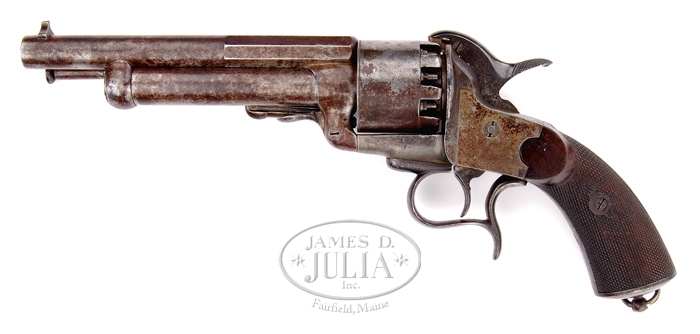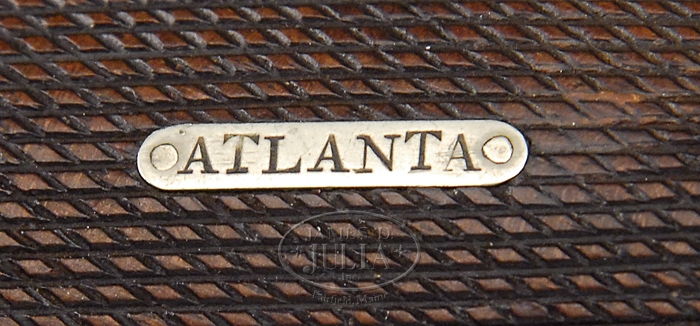



"LeMAT REVOLVER CAPTURED FROM THE CONFEDERATE IRONCLAD “ATLANTA” SERIAL NUMBER 7. SN 7. One of the most historic and important Confederate associated revolvers to come to market in recent memory is this rare First Model LeMat revolver serial number 7. LeMat revolvers were invented by Dr. Jean Alexandre Francois LeMat of New Orleans. The LeMat revolver is a .42 caliber cap & ball black powder revolver which featured a rather unusual secondary 16 gauge smoothbore barrel capable of firing grapeshot. The First Model LeMats were produced in Paris in 1862 and featured a spurred trigger guard, part round, part oct bbl and a swivel lanyard ring attached to the butt cap. All iron, these revolvers had checkered walnut two-piece grips. This is also the lowest SN known on any LeMat. This LeMat is, properly, marked on the top barrel flat “Col. LeMat’s Patent” (pictured in Adams’ book but misidentified as serial number 15). On the right side of the grip is a small silver plate, affixed with two pins and engraved “ATLANTA.” Documentary evidence for the inventory of this Confederate ironclad ship lists three LeMat revolvers. Only two other documented LeMat revolvers exist with Confederate Naval usage. CSS Atlanta , an 1006-ton ironclad ram, was originally built in Scotland in 1861 as the merchant steamship Fingal . In November 1861 she ran the blockade into Savannah, Georgia, with a large cargo of weapons and military supplies. After Union forces closed the exits from Savannah, preventing her further use as a blockade runner, Fingal was converted to an casemate ironclad and renamed Atlanta . She made her first appearance as a Confederate warship in mid-1862. Atlanta made two efforts to attack Federal warships blockading the coast and rivers leading to Savannah. The first, in early 1863, was thwarted by obstructions blocking the route to the sea. In June 1863 Atlanta made her second attempt, targeting blockaders in Wassau Sound. There, on the 17th, she encountered the U.S. Navy monitors Nahant and Weehawken . In a brief battle, Atlanta went aground and was overwhelmed by Weehawken 's superior firepower, forcing her to surrender. The captured ironclad was taken into the Union Navy as USS Atlanta , commissioning for service in February 1864. She was stationed on the James River, Virginia, to support the operations of the army under General Grant. On 21 May 1864, she fired on Confederate cavalry that were attacking Fort Powhatan. A year later, with the Civil War over, Atlanta went north and decommissioned at Philadelphia, Pennsylvania, in June 1865. After several years "in ordinary", she was sold in May 1869. Reportedly, she subsequently became the Haitian warship Triumph and disappeared at sea off Cape Hatteras in December 1869. This is the lowest serial number known among all LeMats, is among the best condition and is among the most historic. What more could you want in a great LeMat? Mr. Michel’s Notes State: “First Model LeMat revolver captured with the surrender of the Confederate ironclad ”Atlanta.“ This revolver, serial number 7, is the lowest serial number revolver with an established Confederate usage. (The revolver is misidentified in ”The Confederate LeMat Revolver“ by Doug Adams as being serial number 15.) Inlet into the right grip is a small silver plate engraved “Atlanta”. The inventory of the ironclad ”Atlanta“ included three LeMat revolvers. The revolver is in superb condition, well marked with the serial number 7 on virtually every component. It is one of only three with known association with the effort of the Confederacy to create a naval force, the other two being serial number 183, captured aboard the Confederate Commerce raider ”Florida“ (also marked on the left side of the frame “Captured in the Rebel Steamer Florida”) and serial number 946, carried by J. N. Maffitt, the Captain of the ”Florida“. The ”Atlanta“ was a refitted iron steamship of English origin which had run the blockade in November 1861. Taken by the Confederate government and rename, the ”Atlanta,“ it was then altered and strengthened for service as an ironclad man-of-war. Leaving the Wilmington River and entering Wassau Sound for the purpose of raising the blockade, at that point it was confronted by the Union monitor,” Weehawken“ under Capt. John Rodgers. The action, as described in James Russell Soley’s book published in 1883, ”The Blockade and the Cruisers,“ was brief: “With the deliberateness which characterized him in the most trying moments, Rodgers delivered the fire of his two heavy guns, the XI-inch and the XV-inch. He fired five shots, of which four hit the ”Atlanta. “The first, a XV-inch cored shot, struck the inclined side of the vessel, in the line of the ports; and though fired at an angle of fifty degrees with her keel, penetrated the armor and, ripping out the wooden backing, the two layers of which were the brittle Georgia pine, covered the deck with splinters. From the effects of this shot, forty or more men were prostrated, several of whom received ugly wounds from the fragments of wood and iron. The second shot, from the XI-inch gun, struck the edge of the overhand, and started the plating. The third carried off the roof of the pilot-house, wounded the two pilots, and stunned the men at the wheel. The fourth shattered a port-shutter, driving the fragments in through the port.” After its capture, it was found that the ship had actually run aground and was apparently unable to maneuver. With the revolver is a copy of a photograph taken of the ”Atlanta “after its capture and a copy of a line drawing of the ship under steam. The octagon to round barrel is marked, correctly, only “Col. LeMat’s Patent”.” CONDITION: Fine, this revolver is well marked, retains a nice dark patina overall with very little pitting. Showing light wear, the LeMat functions mechanically well and is correctly marked with the serial number 7 throughout. A marvelous opportunity to obtain a rare First Model LeMat with long established Confederate Naval usage and capture. One of the finest examples known with a rich history. 4-31368 CW2 (50,000-100,000)"
Back to the index
Reloading kit for pinfire cartridges (5mm,7mm, 9mm & 12mm)
How
does it work?
PRICE LIST

|